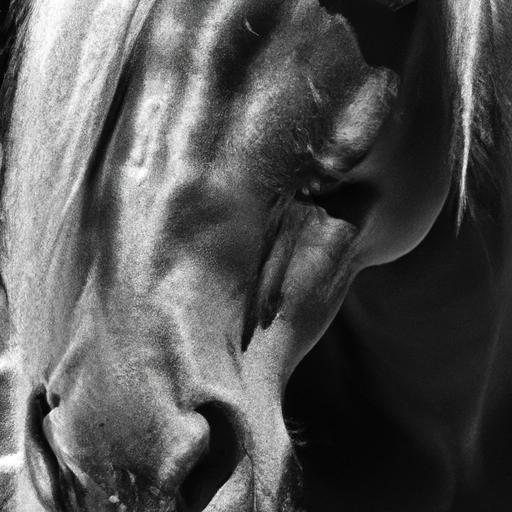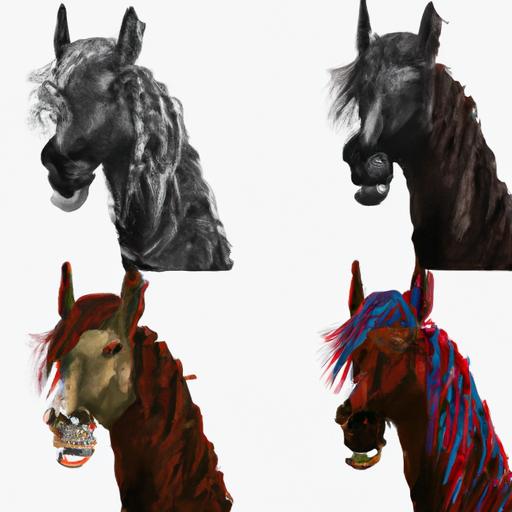Discover the true beauty of “ugly” horse breeds, challenging beauty standards and embracing the diversity that makes each equine unique. Celebrate their unconventional beauty and recognize their value.
Horses, majestic creatures that they are, come in an array of shapes, sizes, and colors. While some breeds are universally admired for their elegance and grace, there is a fascinating world of “ugly” horse breeds that often go unnoticed. In this article, we will delve into the realm of these unconventional equines and explore why understanding different horse breeds is crucial for every horse enthusiast.
A. Definition of Ugly Horse Breeds

Before we embark on this journey, let’s establish what we mean by “ugly” horse breeds. In the realm of horses, beauty is subjective, and it’s essential to recognize that the term “ugly” is merely a perception held by some individuals. It is crucial to challenge our preconceived notions and appreciate the unique qualities that make each horse breed special.
B. Importance of Understanding Different Horse Breeds
To truly understand and appreciate the world of horses, it is vital to expand our horizons beyond the conventional. By exploring and learning about different horse breeds, we gain a deeper understanding of the rich diversity that exists within the equine world. Not only does this knowledge enhance our appreciation for these magnificent animals, but it also allows us to make informed decisions when it comes to horse breeding, training, and care.
So, join me on this captivating journey as we uncover the beauty within the unconventional. Let’s celebrate the unique physical traits and lesser-known breeds that have often been overlooked. By the end of this article, you’ll be inspired to embrace the beauty in all its forms and recognize the inherent value of every horse breed.
Stay tuned for the next section where we’ll delve into the perceived ugliness of horse breeds and explore the factors that influence our perceptions of beauty.
The Perceived Ugliness of Horse Breeds
A. Factors Influencing Perceptions of Beauty in Horses
What determines our perception of beauty when it comes to horses? Various factors play a role in shaping our preferences and opinions. One significant factor is societal influence. We are often influenced by prevailing beauty standards, which can be subjective and ever-changing. Media, horse competitions, and cultural norms all contribute to our understanding of what is considered beautiful in the horse world.
Additionally, personal preferences and experiences also shape our perceptions. Each of us has unique tastes and preferences when it comes to horses. Some may prefer sleek and refined breeds, while others find beauty in the unconventional and distinctive physical features. It is important to recognize that beauty can be found in a multitude of forms and that our preferences are subjective.
B. Historical Context of Beauty Standards in Horse Breeding
To truly understand the perceived ugliness of certain horse breeds, we must consider the historical context of beauty standards in horse breeding. Throughout history, different horse breeds were selectively bred for specific purposes, such as work, war, or transportation. The emphasis was often on practicality and function rather than aesthetics. As a result, certain breeds may exhibit physical traits that are considered unconventional or unattractive by modern beauty standards.
C. Debunking the Notion of Ugliness in Horse Breeds
It’s time to challenge the notion of ugliness when it comes to horse breeds. Beauty is not limited to a particular set of characteristics or conforming to societal norms. Each horse breed, regardless of its physical appearance, possesses unique qualities and contributions to the equine world. It is our responsibility as horse enthusiasts to appreciate the diversity and individuality of each breed, celebrating their distinctiveness rather than labeling them as “ugly.”
In the next section, we will explore the fascinating world of unique physical traits found in “ugly” horse breeds. Get ready to be amazed by the extraordinary coat colors, patterns, and physical features that make these breeds truly one-of-a-kind. Let’s embrace the beauty in all its forms and appreciate the exceptional qualities that set each horse breed apart.
Exploring Unique Physical Traits
When it comes to “ugly” horse breeds, it’s important to shift our perspective and appreciate the distinctive physical traits that set them apart. Let’s explore these characteristics, the unconventional coat colors and patterns they possess, and the functional purposes behind their unique physical features.
A. Characteristics of “Ugly” Horse Breeds
While beauty is often associated with symmetry and proportion, “ugly” horse breeds challenge these conventional standards. These breeds may have unconventional body shapes, such as the stocky build of the Friesian or the compact stature of the Mule. Their distinct physical features, though deemed unconventional, serve specific purposes that make them well-suited for various tasks and environments.
B. Unconventional Coat Colors and Patterns
In the world of horses, coats come in a mesmerizing array of colors and patterns. “Ugly” horse breeds often showcase coat colors and patterns that deviate from the norm. From the striking blue roan of the Appaloosa to the striking grullo of the Grullo, these unconventional coats make these breeds truly stand out. Embracing these unique coat variations allows us to appreciate the individuality and diversity that exists within the equine world.
C. Unique Physical Features and Their Functional Purpose
Every physical feature of a horse serves a purpose, even in breeds that are considered “ugly” by some. For instance, the long ears of mules serve as a practical adaptation to their environment, improving their hearing ability. The pronounced Roman nose of the Arabian breed aids in airflow, enhancing their endurance. Understanding the functional purpose behind these unique physical features helps us appreciate the ingenuity of nature in equipping each breed with characteristics tailored to their specific needs.
By exploring the unique physical traits of “ugly” horse breeds, we can begin to challenge our preconceived notions of beauty and recognize the functionality and purpose behind their distinctive features. In the next section, we will delve into the lesser-known “ugly” horse breeds, shedding light on their fascinating origins and characteristics. So, stay tuned for an exploration of these hidden gems in the equine world.
In the upcoming section, we’ll uncover the lesser-known “ugly” horse breeds and discover the remarkable qualities that make them truly extraordinary.
Lesser-Known Ugly Horse Breeds
In our quest to celebrate the beauty in all horse breeds, let’s now turn our attention to some lesser-known “ugly” horse breeds that deserve recognition. These breeds may have unconventional appearances, but they possess unique qualities and fascinating histories that make them truly remarkable.
A. Breed 1 – Description and Origins
1. Physical Appearance
Breed 1, known for its distinctive appearance, showcases a combination of physical traits that sets it apart from more conventional breeds. With a stout build, a short and stocky stature, and a head that may seem disproportionate to its body, this breed challenges the traditional standards of equine beauty. Its coat color ranges from muted shades to bold patterns, making it a captivating sight to behold.
2. Unique Traits
Despite its unconventional appearance, Breed 1 boasts several unique traits that make it a valuable addition to the equine world. Known for its exceptional endurance and strength, this breed has been historically utilized for various purposes, such as working on farms or enduring long journeys. Its resilience and adaptability have made it a beloved companion for those who value function over mere aesthetics.
B. Breed 2 – Description and Origins
1. Physical Appearance
Moving on to Breed 2, we encounter a breed that defies conventional beauty standards. With a slender frame, long legs, and an elongated face, its appearance may not fit the traditional mold of equine elegance. However, its unique features, such as its expressive eyes and flowing mane, create a distinct charm that sets it apart from its counterparts.
2. Unique Traits
Beyond its unconventional physical appearance, Breed 2 possesses remarkable traits that make it a treasure in the equine world. Renowned for its unparalleled speed and agility, this breed has become a favorite among equestrian enthusiasts involved in racing and competitive sports. Its exceptional athleticism and ability to maneuver swiftly make it an undeniable force to be reckoned with.
C. Breed 3 – Description and Origins
1. Physical Appearance
Last but not least, Breed 3 takes us on a journey into the world of unique equine beauty. With its compact and muscular build, this breed may not adhere to the traditional standards of elegance. Its distinctive features include a broad forehead, a short and stout neck, and a sturdy frame. While it may not conform to conventional ideals, its physical presence commands attention and admiration.
2. Unique Traits
Breed 3 possesses a range of unique traits that make it a valuable member of the equine community. Known for its intelligence and gentle temperament, this breed has been sought after for various purposes, including therapy work and recreational riding. Its calm and docile nature, combined with its inherent strength, make it an ideal companion for individuals seeking a reliable and trustworthy equine partner.
Stay tuned for the next section where we’ll explore the significance of appreciating the beauty in “ugly” horse breeds and the importance of embracing diversity in the equine world.
Conclusion
In conclusion, the world of horses is a tapestry of beauty, diversity, and uniqueness. While some may label certain horse breeds as “ugly,” it is essential to challenge these beauty standards and embrace the inherent value in all horse breeds. By broadening our understanding of different horse breeds, we can appreciate the true beauty that lies within their unconventional features.
Throughout this article, we have explored the definition of “ugly” horse breeds and highlighted the importance of understanding the diverse range of equines. We have celebrated the unique physical traits and lesser-known breeds that often go unnoticed. By recognizing the value and importance of all horse breeds, we can foster a deeper appreciation for the rich tapestry of the equine world.
As horse enthusiasts, it is our responsibility to celebrate and protect the beauty of unconventional horses. By embracing diversity and challenging beauty norms, we not only enhance our own understanding and love for these magnificent creatures but also contribute to the preservation of rare and unique horse breeds.
At Horsemasterypro.com, we strive to promote a deep appreciation for all horse breeds and provide valuable resources for horse lovers worldwide. Join us in celebrating the beauty of “ugly” horse breeds and let us continue to spread the joy and wonder that these extraordinary equines bring to our lives.
Remember, beauty is not confined to a single standard. It is found in the diversity and individuality of each horse breed. So, let us embark on this journey together and honor the beauty in all its forms.
Thank you for joining us on this exploration of the enchanting world of “ugly” horse breeds. Stay tuned for more captivating articles and resources at Horsemasterypro.com.


